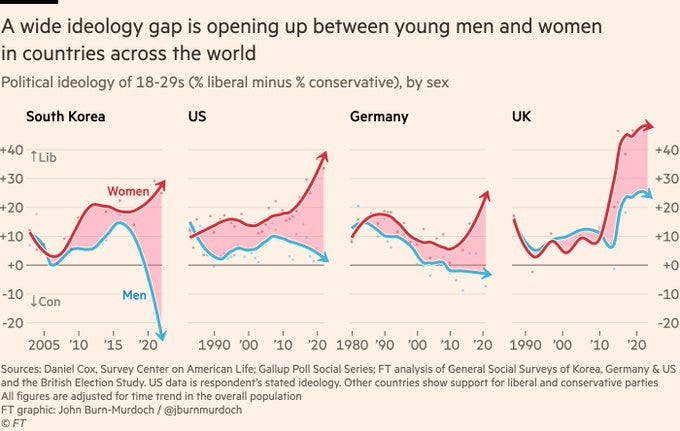The New Political Divide - Gender
Across the Western world, a wide ideology gap is opening up between young men and women, risking inter-personal relations and the amicability between the sexes.
A recent article from the Financial Times has gone viral lately. The article details a new, striking political divide that is manifesting in Western, developed countries. Over four selected countries - South Korea, USA, Germany and the UK - young women were found to be veering further to the left, adopting stronger progressive stances on everything from immigration to climate change, while young men were found to be trending in the opposite direction. The results confirmed one thing: Gen Z is two generations, not one.
Historically, the views of men and women in the same generations have been roughly similar, with any gaps more down to the style or presentation of a certain leader than anything else. But a new, much wider gulf has emerged between today’s young men and women.
After reading the data, two key questions immediately spring to mind: What is causing this? And what are its implications?
Like any issue this multifaceted, there is no easy answer. A variety of factors, both social and economic, intersects and widens the gap, with some existing for a long time and others only emerging through this new era of information.
One theory is negative polarisation. In the wake of the MeToo movement, young women have both become more progressive and more vocal about their views, often calling for more accountability of those in power. Such messages, rightly or wrongly, can and have been construed as a broader attack on masculinity, leading to many young men feeling threatened and reacting by taking the opposite position. This could explain how the divide on gender issues bleeds into other spaces. If some young men think "young women are woke, so, therefore, I am not", then they will instinctively take non-woke positions on other topics to distance themselves in a bid to cherish their own masculinity.
A complementary theory is that these trends are explained by young men and women increasingly inhabiting different spaces. Since so much of daily life now plays out online, by segregating themselves into different parts of the internet, young men and women are being fed different content, driving a wedge further between them. Algorithmically walled gardens of TikTok, if you will. It’s partially how Andrew Tate and the rest of the manosphere were able to cultivate a devout following of fans. While his views on women may seem reprehensible to most people, cocooned in their echo chambers, emotionally vulnerable men become susceptible to his easy-to-digest subscriptions and use his confrontational worldview as a coping mechanism to deal with their increasing social isolation.
Another factor, and one perhaps less comfortable to discuss for social progressives, is the innate characteristics of the sexes. Women are, on average, more socially naive and susceptible to, what I like to call, altruistic propaganda - the belief that every person should be protected and coddled. This is reflected in the study: women are in favour of rehabilitative justice, call for less stringent border policies, and support marginalised groups. This may also correlate with educational attainment as well, since women are more likely to attend and graduate from university than men.
Finally, one more contributing factor that cannot be ignored is the inherent misandry of the contemporary feminist movement. Some feminists, particularly the more militant, intersectional ones, have a tendency to minimalise and trivialise men's issues, be it depression, isolation, or anxiety, resulting in them being driven further into the arms of the right. Though some women may resent the idea of coddling men, especially as they encounter and experience their own issues - from systematic sexual assault to unachievable body standards - at best ignoring men and at worst mocking them is only exacerbating the divide.
In the absence of a genuine left-wing alternative, right-wing politics have served as a conduit to channel these male grievances. Without a coordinated strategy to reverse or, at least, alleviate these trends, the problems will, in all likelihood, persist and worsen, resulting in two halves of a generation who find each other’s views incomprehensible at best, and intolerable at worst. The impact this will have on the dating culture, birth rates and overall social cohesion in contemporary society needs no elaboration.
One thing that would help is de-segregating online spaces. If top influencers spoke to both sexes instead of just one, that could begin bridging the divide. Will this happen? Almost certainly not.
Bridging the gap will have to come more from men than women, but diagnoses of "toxic masculinity" only exacerbate the problem, causing further negative polarisation. Young men need better role models, but it’s not their fault they don’t have them.
Until broader society is ready to have an adult conversation around the implications stemming from this trend, expect the situation to worsen before it gets any better.


